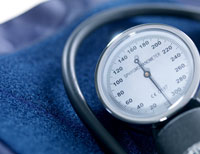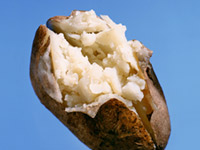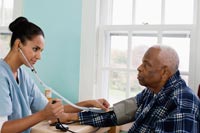The blood pressure cuff tightens around your arm. As it deflates, your doctor's eyebrow lifts slightly. Then comes the bad news. Your blood pressure is elevated.
Sign up for the AARP Health Newsletter.
This year, millions of Americans will be diagnosed with hypertension. The older you are, the greater the likelihood that your numbers will climb into the danger zone, commonly thought to be a systolic pressure (the upper number) of 140 or higher, or a diastolic pressure (the lower number) of 90 or more.
Blood Pressure at 65+
A hypertension diagnosis should be based on multiple readings. — Science Photo Library/Getty Images

While a blood pressure reading of 120/80 is considered to be the norm for most adults, an expert panel convened by the American College of Cardiology (ACC) and the American Heart Association (AHA) recommends the following measurements for older people:
Age 65 to 79: 140/90 or less
Age 80+: 140/90 to 145/90
- New treatment guidelines for high blood pressure. Read
But as you age, the story those numbers tell about your health can be very different from the one they conveyed when you were a decade or two younger.
Unfortunately, "many doctors are ill-prepared to treat high blood pressure in older people," says Dr. Joseph L. Izzo, professor of medicine at the State University of New York at Buffalo and a leading expert on hypertension.
Some older people are being given blood pressure drugs that may be dangerous for them. Others are being undertreated — or overtreated.
"On the wrong dosages of medication, older people are at risk of fainting and falling," says Dr. Alexander G. Logan, a hypertension expert at Mount Sinai Hospital in Toronto. "And when a frail older person falls, it can be devastating."
What can you do to ensure that your blood pressure is being treated appropriately? A good place to start is by asking your doctor a direct question:
Do I really have high blood pressure?
One blood pressure reading, done in a doctor's office, isn't enough to diagnose hypertension.
"Blood pressure changes every second of the day," says Dr. Sharon Brangman, a professor of medicine at the State University of New York at Buffalo and president of the American Geriatric Society.
Most people's numbers are higher during the day and lower during sleep. Stress can boost blood pressure. So can eating a big meal.
Doctors have long been familiar with the phenomenon of "white coat hypertension" — the tendency for some people's blood pressure to shoot up when it's tested in a doctor's office. But the opposite can also happen. Blood pressure readings may be perfectly normal at the doctor's office and elevated as soon as the person gets home, a condition called "masked hypertension."
Next: How do you know if you really have high blood pressure? »
So how do you know if you really have high blood pressure?
First, make sure that the office reading is done correctly. "Readings should be taken only after you've been sitting or lying down for five or 10 minutes — not just after you've raced into the office," Brangman says.
It's also a good idea for your doctor to get a second reading after you stand up. (As you get older, the mechanism that increases blood pressure automatically when you get out of bed or a chair can become less responsive, making you prone to falls. This is a condition called orthostatic hypotension.)
If your office numbers are indeed high, ask your doctor about a home blood pressure monitor. These easy-to-use devices allow you to test your own blood pressure at various times during the day, which can help your doctor rule out both white coat hypertension and masked hypertension.
<p>"Up until about 10 years ago, doctors only paid attention to diastolic hypertension. Now we know it's really systolic hypertension that matters in older people."</p>
In some cases, doctors recommend ambulatory blood pressure testing, using a device that automatically takes readings of blood pressure over a 24-hour period. Ambulatory testing can identify people whose pressure doesn't fall during the night, as it should. This phenomenon, called "non-dipping," becomes more common as people age and has been shown to increase cardiovascular and stroke risk.
What should my numbers be?
High blood pressure in older people is very different from the condition in middle age.
"When people develop high blood pressure in middle age, the problem is typically elevated diastolic pressure, which is indicated by the lower number," says Izzo. Ideally, the goal is to bring the numbers down close to a normal reading of 120/80.
Once you hit age 60, though, it's the upper number — the systolic pressure — that can really climb, causing concern. Systolic hypertension occurs when the arteries close to the heart begin to stiffen, making them less responsive to blood flow.
"In a sense, you have almost two forms of hypertension," Logan says. "Up until about 10 years ago, doctors only paid attention to diastolic hypertension. Now we know it's really systolic hypertension that matters in older people."
Further, many older people develop a condition called wide pulse pressure, in which diastolic pressure drops even as systolic pressure climbs. The widening gap between the upper and lower numbers has been shown to be an independent risk factor for heart disease and stroke.
It also poses a tricky challenge for doctors. Drugs that lower systolic blood pressure typically bring down diastolic blood pressure, too. If that number is already low, medications can prove risky.
Next: Do you really need medication? »
Do I really need medication?
Doctors need to tread carefully when treating older adults for hypertension, explains Logan. "Chronological age is less important than overall health," he says. "I'd treat a very healthy 80-year-old as I would any [middle-aged] hypertensive. But in many older people, the target needs to be carefully adjusted to avoid complications."
High blood pressure increases the risk of heart attack and stroke, but very low blood pressure is dangerous, too, he points out. Abnormally low diastolic pressure, for instance, means not enough blood is flowing back to the heart. That can deprive the heart of oxygen, causing it to enlarge, and can rob the brain of blood.
Foods That Fight Hypertension
Yes, a baked potato is good for your blood pressure — Brian Hagiwara/Getty Images

Many of the foods you already enjoy — blueberries, cereal, baked potatoes — can help lower your blood pressure.
- 6 fabulous foods that fight high blood pressure. Read
In someone with a wide pulse pressure, getting systolic pressure down without driving diastolic pressure too low can become a real balancing act.
"Let's say a patient has 160/60," says Dr. Howard S. Weintraub, associate professor of medicine and director of the Center for the Prevention of Cardiovascular Disease at New York University Langone Medical Center. "You can't go any further in those individuals or you may see unwanted consequences of low diastolic blood pressure."
Doctors also have to be cautious about treating people who are hypertensive but have transient low blood pressure when they stand. Bringing overall blood pressure down may increase the danger of falls.
Despite the challenges of treating hypertension in older patients, researchers emphasize the importance of controlling high blood pressure.
"If you can take someone with a systolic blood pressure of 180 and get it down to 150, you knock the tar out of the stroke rate," says Izzo. And especially as people get older, a stroke can prove much more calamitous than heart disease.
What are the best drugs for me?
Medications that work well for younger people with hypertension can be dangerous in older patients. Experts caution against using beta blockers, such as Inderal or Toprol XL, in older people because they may slow already sluggish heart rates.
Next: Managing your blood pressure without meds. »
Managing Your Blood Pressure Without Meds
Your blood pressure can vary based on whether you're sitting, standing or lying down. — Caterina Bernardi/Corbis

If your blood pressure isn't too high, you may be able to bring it down without having to take pills. The prescription:
- Eat more fruits and vegetables (at least five servings a day)
- Choose low-fat dairy products
- Cut back on salt (for instance, reach for low-salt packaged foods and avoid salty snacks such as pretzels)
- Go easy on sugary foods and beverages, such as soft drinks, candies and pastries.
- Engage in a physical activity, such as brisk walking, for 30 minutes most days of the week
- Lose a little weight if you're overweight (even just a few pound will help)
Studies show that this combination of healthy habits can lower the risk of getting high blood pressure and bring moderately elevated numbers back down.
While some experts prefer using a single agent at a dose high enough to bring the numbers into line, others favor a combination — a diuretic paired with an ACE inhibitor, for example, or a diuretic combined with a CCB (calcium channel blocker). Several of the most common pairings now come in combination pill forms, which cut down on the number of pills needed — an important advantage for anyone taking multiple medications.
Recent findings suggest that CCBs may offer a special advantage for older patients. Researchers have long assumed that controlling high blood pressure would lower the risk of memory problems and dementia in older people. But few studies found any significant benefit. Last year, however, in a study of 375 hypertensive patients 60 and older, researchers at Nancy University Hospital in France reported that people on CCBs showed improvement in memory scores. By contrast, those who took other types of drugs for their high blood pressure showed no memory gains.
Whatever your doctor prescribes, chances are your regimen will need to be adjusted over time. And even though you may need to take medication, researchers all agree that it's important to follow the familiar advice: minimize salt intake, eat plenty of fruits and vegetables, maintain a healthy weight and be as physically active as possible.
"All of those changes can mean you can get by on less medication, which means fewer side effects," says Weintraub. "And in many ways besides lowering blood pressure, you'll be a lot healthier."
Peter Jaret is a frequent contributor to AARP. He has written seven books, most recently "Nurse: A World of Care."
Member Discounts! Save on eye exams, prescription drugs, hearing aids and more
Source: https://www.aarp.org/health/conditions-treatments/info-05-2011/high-blood-pressure-older-adults.html
Posted by: visallicecilnoes.blogspot.com